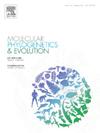Cryptic species, biogeography, and patterns of introgression in the fish genus Mogurnda (Eleotridae) from the Australian wet tropics: A purple patch for purple-spots
IF 3.6
1区 生物学
Q2 BIOCHEMISTRY & MOLECULAR BIOLOGY
引用次数: 0
Abstract
Accurately delimiting species is an essential first step towards understanding the true biodiversity of an ecosystem and any subsequent efforts to identify and protect taxa at risk of extinction. Current molecular evidence suggests that purple-spotted gudgeons (genus Mogurnda) harbour high levels of cryptic biodiversity across their broad distributional range. The present study uses a large single nucleotide polymorphism (SNP) dataset plus a companion allozyme dataset to clarify taxonomic uncertainty, patterns of introgression, and biogeographic relationships among Mogurnda populations within the Queensland Wet Tropics (QWT), a known biodiversity hotspot. Both datasets were strongly concordant in identifying a total of seven taxa split among distinct southern, northern, and lowlands groups. No two taxa were found in strict sympatry, but many appear to be parapatric and occur within the same drainage basin. Although clear evidence of introgression was only evident at six sites (∼4%), the genomic signature of modest historic admixture between proximally-distributed taxa was detected at multiple other sites. Nevertheless, all primary genetic and phylogenetic analyses strongly supported the integrity and diagnosability of these seven taxa. We therefore nominate these as novel candidate species for what appears to be yet another hyper-cryptic complex within the Australian freshwater ichthyological fauna. These results offer up intriguing ecological scenarios and conservation implications for multiple candidate species with narrow ranges in specialised habitat. We conclude by exploring the major biogeographic patterns displayed by QWT Mogurnda.

来自澳大利亚湿热带地区的鱼属Mogurnda (Eleotridae)的隐物种、生物地理和渗入模式:紫色斑点的紫色斑块。
准确地划分物种是理解生态系统真正的生物多样性和随后识别和保护濒临灭绝的分类群的重要的第一步。目前的分子证据表明,紫斑鸽子(Mogurnda属)在其广泛的分布范围内隐藏着高水平的生物多样性。本研究使用大型单核苷酸多态性(SNP)数据集和伴随的等位酶数据集来澄清昆士兰湿热带地区(QWT)内Mogurnda种群的分类不确定性、渐入模式和生物地理关系。两个数据集在确定南、北、低地群的7个分类群方面是高度一致的。没有发现两个分类群是严格同属的,但许多分类群似乎是异栖的,并发生在同一流域内。虽然只有6个位点(约4%)存在明显的基因渗入证据,但在其他多个位点发现了近地分布的类群之间适度的历史混合的基因组特征。尽管如此,所有的原始遗传和系统发育分析都有力地支持了这7个分类群的完整性和可诊断性。因此,我们提名这些作为新的候选物种,似乎是澳大利亚淡水鱼类学动物群中另一个超隐体复合体。这些结果为在特定栖息地范围狭窄的多种候选物种提供了有趣的生态情景和保护意义。最后,我们探讨了QWT Mogurnda表现出的主要生物地理格局。
本文章由计算机程序翻译,如有差异,请以英文原文为准。
求助全文
约1分钟内获得全文
求助全文
来源期刊
CiteScore
7.50
自引率
7.30%
发文量
249
审稿时长
7.5 months
期刊介绍:
Molecular Phylogenetics and Evolution is dedicated to bringing Darwin''s dream within grasp - to "have fairly true genealogical trees of each great kingdom of Nature." The journal provides a forum for molecular studies that advance our understanding of phylogeny and evolution, further the development of phylogenetically more accurate taxonomic classifications, and ultimately bring a unified classification for all the ramifying lines of life. Phylogeographic studies will be considered for publication if they offer EXCEPTIONAL theoretical or empirical advances.

 求助内容:
求助内容: 应助结果提醒方式:
应助结果提醒方式:


